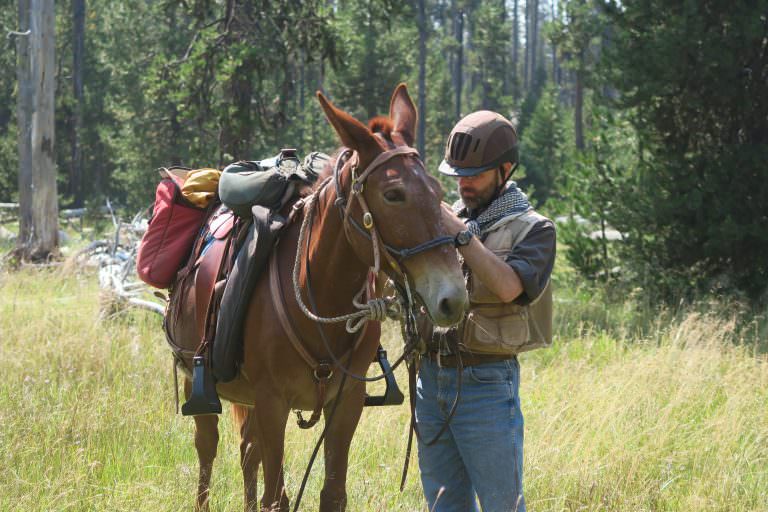The Most Dangerous Mistakes are Those Not Recognized
By Robert Eversole

The advice I usually give in my articles is about avoiding mistakes. But what defines a mistake? And how do you recognize one? After all, one person’s gaffe could be another’s routine. Many drivers, for example, don’t wear seat belts. And those folks do just fine—until they wreck. Before the accident, the mistake wasn’t visible to them. If it had been, they would have buckled up. Instead it was a bad habit that they didn’t recognize. And because they didn’t see it, they didn’t fix it.
Human nature encourages us to pursue the path of least resistance, which often means doing things the same old (and maybe wrong) way until we get caught.
How does this affect those of us who play outdoors? Horse and mule riders practice bad habits just like everyone else. In fact, trail veterans who maintain a “that’s the way I’ve always done it” attitude are some of the worst offenders. Maybe at one time you could clean out your trailer wherever you wanted, but not anymore. The same goes with weedy hay and burning trash in the back country.
To become better and safer trail riders we need to recognize which of our habits are mistakes. These are bad decisions we make while planning trips, packing gear, or riding the trail. And while not wearing a seat belt seems like an obvious error, some of the most common outdoor blunders are just as knuckleheaded.
How do you uncover your own bad habits? You’ve got to examine your pre-trip and on-trail routines. Or better yet, ask your friends and hiking partners for feedback and advice. To get started, here are four of trail riding’s most wanted mistakes.
1. Not leaving information with a responsible person
Always tell someone where you’re going, the route you plan to take, and when you expect to be back. And here’s the important part: do it for every trip, not just the ones you think are dangerous. Whether you plan your ride a week ahead or wake up that morning with an itch for the trail, taking a few extra minutes to sketch out an itinerary is always worthwhile.
Creating a plan and leaving it with friends or family is a safety basic, and one to cultivate into a habit. It prevents unnecessary anxiety and, in an emergency, will save precious time for search and rescue responders. You can download our Ride Itinerary Form at www.trailmeister.com/trail-ride-itinerary.
Creating an itinerary also forces you to think about, and include, a backup plan. If you ride regularly, it’s inevitable that something—from wildfire to a washout to a full trailhead—will force you to change your plan on the fly.
2. Riding without a map
The difference between a complacent and a clever trail rider is realizing you don’t need a map, but bringing one anyway. When do experienced riders get lost? Not the first time they explore a new trail with a good map in hand. And not the 100th time, when they know the route well. The danger zone is the second, third or fourth outing, when overconfident riders convince themselves they don’t need a map, but actually do. Miss a crucial turn or gamble on a shortcut, and an easy trail quickly becomes a maze of doubt.
3. Forgetting a headlamp
You might be planning “just a day ride” but take a hint from the Gilligan’s Island crew who expected a three-hour tour and got 99 episodes instead. A thousand unforeseen problems could strand you on the trail after sunset. Packing a 3-ounce headlamp or flashlight can prevent a wretched overnight in the woods. Once you’ve had that experience, you won’t ever forget a flashlight again.
4. Not checking your cinch
Think of the cinch or girth on your saddle like your seat belt in your car. The cinch is what keeps your horse’s saddle properly placed on his back. While I’m sure you always check the horse’s cinch before you mount the horse, often times the cinch will loosen up during a ride as the animal warms up. Fight the urge to say, “It’ll be ok.” It won’t be. Readjust the saddle and tighten the cinch.
What’s your favorite trail rider faux pas?
As always for more tips on trail riding and camping with equines, and the world’s largest and most accurate horse trail and camp guide visit www.TrailMeister.com.

Robert Eversole, ”the trail meister,” owns www.TrailMeister.com, the largest database of horse riding and camping areas in the U.S. with free trail and trailhead information, trail maps, and much more to help horse enthusiasts experience the joys of trail riding. Robert is a registered riding instructor with PATH International, a mounted search and rescue team member, and a U.S. Marine who has served on the board of the Backcountry Horsemen of Washington (BCHW). He is enjoying his new career helping fellow trail riders stay found and safe on the trail. When not on the trail, The Trail Meister resides near Spokane, WA and teaches land navigation to a wide variety of outdoor groups across the nation. For North America’s largest horse trail and camping directory, trail tips, and more, visit www.TrailMeister.com.

